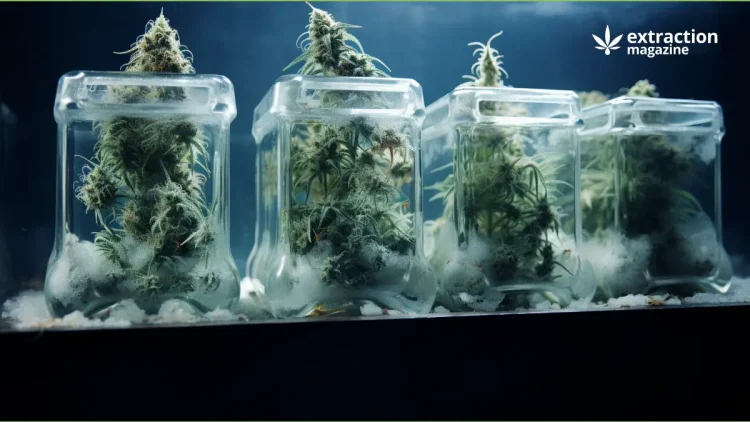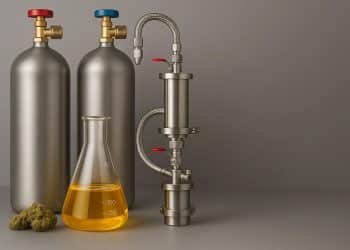Agriculture marks the first major technological revolution in human history. [1] With a consistent and reliable supply of food, humans were able to transition from hunters and gatherers to community minded city dwellers. This became the foundation that lead to the written word, the scientific method, and all other technological advancements in human history.
There was one problem with this development of having a constant supply of food: how to store the abundance of food so it would last through times of scarcity? For centuries, various civilizations relied on techniques like salting, smoking, or cold weather to preserve their food for extended periods, but in 1834 the first vapor compression refrigeration system was invented. [2]
Finally, consistent storage capabilities were possible for large amounts of food. Freezing has even gone a step further into a technique called “deep freezing.” But what is the difference between freezing and deep freezing, and which method is more beneficial?
The Differences Between Freezing from Deep Freezing
While the process may sound similar, there are some key differences that are worth identify before delving into which process is more ideal. Freezing involves slowly cooling the desired product over an extended period of time.[3] This cooling can take anywhere from one to 24 hours before the internal core temperature eventually reaches -18º C. This temperature is the target for both freezing and deep freezing, as it allows for extended storage by limiting the growth of microorganisms. This variation of freezing, by slowly exposing products to the cold, is the way most people are familiar with in their standard kitchen appliance.
Deep-freezing, in contrast, uses a more aggressive approach to reach the same target of -18º C. [4] Instead of extending the cooling period, deep-freezers involves the exposure of the stored material to temperatures ranging from -30º C to -60º C for typically less than an hour. This forces the desired material to reach that frozen core temperature much faster, before it is deposited into long term storage to maintain its frozen stasis.
The end result for both procedures is the same. Both minimize microorganism thereby preventing the degradation of food quality. There are some key differences though, and, while subtle, these differences are significant factors in how the final product turns out.
Physical Differences on a Microscopic Level
The similarities between these two procedures are obvious, but the differences become clear when evaluating the frozen products on a molecular level. In both instances, water molecules transition into their crystallized form of ice. When freezing, these ice crystals tend to be bigger, as they can grow more slowly with the extended time to develop. [5]
With a deep freeze, the sudden onset of cold forces more crystals to develop simultaneously, making them significantly smaller by comparison. Basically, the total volume of ice is the same, but there is a difference in the quantity and size of the ice crystals. This may not seem significant, but it plays a major role when thawing the frozen products.
The larger ice crystals from freezing create undesirable results, especially in material with a lot of water. When items with high water content freeze, the ice crystals tear through the cell walls, breaking down the organic material. An example of this comes from putting leafy vegetables in a household freezer. When the vegetables come out, the freezing reduces their freshness, smell, taste, and nutritional content. The higher water content in these kinds of vegetables makes freezing them an impossibility, as their cellular structures are often destroyed to the point where they are inedible.
This explains why deep freezing is the preferred method for keeping vegetables fresh for long periods of time. Say a farmer grows some spinach, and they need it to go from the farm and a grocery store. The smaller ice crystals from the deep freeze ensure that no structural damage occurs in the spinach. This small difference ends up having a profound effect in markets all over the world.
The smaller crystallization of moisture allows the plants to be kept for longer periods of time, and still maintain their freshness, texture, and vitamins by the time they are thawed. This ensures food security by allowing the food to be kept longer and by allowing the food to be sourced from further distances.
Which Requires More Energy?
In terms of maintaining quality for the frozen products, it would appear that deep-freezing holds the advantage. Another aspect to consider when evaluating which method is superior is energy consumption. It would seem that deep-freezers probably require more energy to operate, considering it takes more power to reach the colder temperatures. In fact, the opposite is true.
A normal freezer consumes an average of 41.69 W of electricity per day, compared to a deep-freezer’s average of 24.91 W per day. That equates to 40.24% less electricity for deep-freezing. [5] There are two reasons for this. Though it takes a lot of energy to cool a deep freezer, that energy is used for a significantly shorter period of time. Once the frozen products reach their desired core temperature of -18º C, they can be moved to long term storage, where they can remain indefinitely until they need to be thawed.
The long term storage requires less energy than the initial freezing, meaning the higher energy usage is not consistently being employed. The spikes and troughs from deep freezing leads to a lower overall average consumption over extended periods. The second reason deep freezers typically use less energy than freezers has to do with how often they are accessed. Household freezers also experience spikes in energy as well, but it comes from customers opening them more regularly.
Most people open their freezers less than frequently than their refrigerators, but every time a freezer is opened, some cold air escapes. This causes the system to overwork to make up the difference lost, thereby maintaining those freezing temperatures. This produces smaller energy spikes, but they come at more regular intervals. So while the differences between the peaks and valleys are smaller, the wavelengths are shorter.
Way to Improve Freezing Techniques
It’s logical that deep freezing is more advantageous over freezing. If freezing were perfect in the first place there would have been no need to push the technology to improve results. Even now, new techniques are being developed to further optimize deep freezing. [7] Deep freezing may be superior in most ways, but freezing does have one advantage itself: it is a less complicated system to set up and use.
Deep freezers require higher technical specifications, and if their standards aren’t met then the products can spoil. [8] This is why standard freezers are more common. Due to this complexity, deep freezing is typically better suited to large institutions, whereas freezing tends to serve individuals better. This being the case, there are a few things individuals can do to minimize the downsides of freezing. In terms of damages coming from larger ice crystals, it is possible to reduce the moisture of the items being frozen prior to putting them in the freezer.
Depending on the product, this may take the form of dehydration or may be more reasonable to use vacuum sealing. For something like meat or fish, sealing moisture out of containers tends to be sufficient. For various fruits and vegetables, dehydration may be preferred, but this is not feasible for all organic products. Another way to prevent increased freezer damage is to keep an item frozen until it is ready to be thawed. Continually thawing and refreezing items means that the water molecules will grow and expand in new directions, creating more molecular damage than with a single freeze.
Some experts advocate rotating items within a freezer to prevent freezer burn, but doing so may increase energy consumption. Instead, it is better to avoid opening the freezer until it is time to thaw the desired items. The more often the door is opened, the more often freezers lose their cold air and have to increase their outputs. These are not perfect solutions, and they do not necessarily raise freezing to the level of deep freezing, but they may produce positive results.
References:
- Maisels, Charles Keith. The emergence of civilization: from hunting and gathering to agriculture, cities, and the state in the Near East. Psychology Press, 1993.
- Ding, Guo-liang. “Recent developments in simulation techniques for vapour-compression refrigeration systems.” International journal of refrigeration 30.7 (2007): 1119-1133.
- Assegehegn, Getachew, et al. “The importance of understanding the freezing step and its impact on freeze-drying process performance.” Journal of pharmaceutical sciences 108.4 (2019): 1378-1395.
- Lee, SangYoon, et al. “Deep freezing to maintain the freshness of pork loin during long-term storage.” Food Science and Biotechnology 30.5 (2021): 701-710.
- Tan, Mingtang, Jun Mei, and Jing Xie. “The formation and control of ice crystal and its impact on the quality of frozen aquatic products: A review.” Crystals 11.1 (2021): 68.
- F, J. (2023). Freezer Wattage Results [Most efficient revealed 2023]. Eco Cost Savings.
- Le Pierrès, Nolwenn, Driss Stitou, and Nathalie Mazet. “New deep-freezing process using renewable low-grade heat: From the conceptual design to experimental results.” Energy 32.4 (2007): 600-608.
- National Cold Chain Management Information System. (2015, July 21). Technical Specifications – Deep Freezer (Large). nccmis.org. Retrieved August 14, 2023












